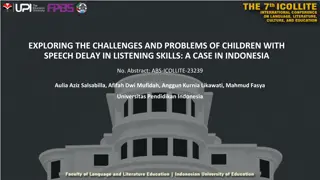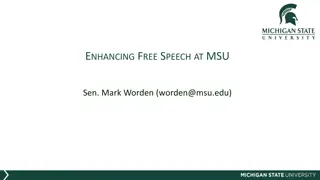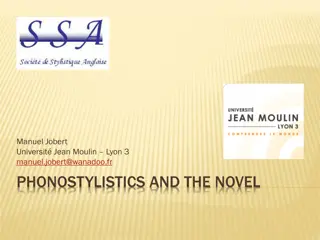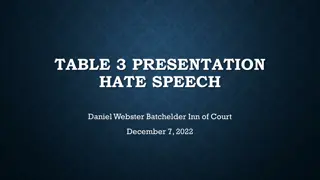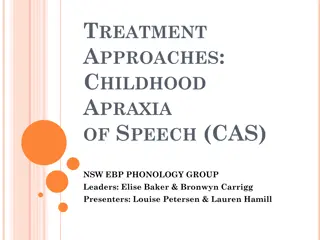Insights into Child-Directed Speech Variations and Effects
Research examines variations in child-directed speech due to caregiver gender, with fathers often being more demanding than mothers. Such speech impacts children's attention, language accessibility, and learning mechanisms, showcasing contrasting views on its effectiveness. The article delves into phonological, lexical, and grammatical aspects of child-directed speech, supported by theories emphasizing caregiver interactions and language development. Notably, cultural differences in language acquisition approaches are explored, shedding light on diverse practices across different societies.
Download Presentation

Please find below an Image/Link to download the presentation.
The content on the website is provided AS IS for your information and personal use only. It may not be sold, licensed, or shared on other websites without obtaining consent from the author.If you encounter any issues during the download, it is possible that the publisher has removed the file from their server.
You are allowed to download the files provided on this website for personal or commercial use, subject to the condition that they are used lawfully. All files are the property of their respective owners.
The content on the website is provided AS IS for your information and personal use only. It may not be sold, licensed, or shared on other websites without obtaining consent from the author.
E N D
Presentation Transcript
Child Directed Speech Revision Are there are variations due to the gender of the caregiver? Research has suggested that fathers are more demanding than mothers, using more direct questions and a wider range of vocabulary. What effects do you think this kind of speech has on children? Some claim that it retains the attention of the child, others that it makes language more accessible. Some claim that children learn by repetition can this explain the fact that children can produce sentences which they have never heard before? Others claim that babytalk actually interferes with language development because children learn babyish words and sentences instead of the real language. Not every culture uses such forms of child-directed speech. In Samoa and Papua New Guinea, adults speak to children as they speak to adults, and children acquire language at the same pace as elsewhere.
Phonology Slower, clearer pronunciation More pauses, especially between phrases and sentences Higher pitch Exaggerated intonation and stress
Lexis Simpler, more restricted vocabulary Diminutive forms (e.g. doggie) Concrete language, referring to objects in the child s immediate environment
Grammar Simpler constructions Frequent use of imperatives High degree of repetition Repeated sentence frames, using the same sentence structure, changing one part every time, e.g. That s a Frequent questions Use of personal names instead of pronouns (e.g. Mummy not I ) Frequent use of child s name Absence of past tenses Reduced number of plurals and possessives (e.g. planets, Mummy s) Fewer verbs, modifiers and adjectives Large number of one-word utterances Deixis used to point child s attention to objects or people Use of expansions, where the adult fills out the child s utterance Use of re-castings, where the baby s vocabulary is re-used in a new utterance
Theories Clarke-Stewart (1973) Children whose mothers talk to them more have larger vocabularies. Nelson (1973) Children whose mothers corrected them on word choice and pronunciation actually advanced more slowly than those with mothers who were generally accepting. Children often make virtuous errors mistakes that show an overextension of a grammatical rule, e.g. They throwed him in Kuhl (1992) Studied exaggerated vowel sounds used by parents when speaking to 6-month olds (in English, Swedish and Russian). Babies turn towards adults who speak in sing- song voice, ignoring regular conversation. Mothers in all three countries exaggerated the important vowels.
Theories Bruner: Social interactive approach puts forward idea that interactions between child and carer are crucial to lang development and help children develop important abilities such as turn-taking. Importance of conversations, routines of social interaction, Must be LASS (support system) as well as LAD. Parents provide ritualised scenarios bath, meal, getting dressed phrases of interaction rapidly recognised and predicted Lee Vygotsky - a Russian pyschologist had similar views to Piaget. He also believed that collaborative play has an influence and essential part in a child's early development. In instances where the emphasis is put more on play than teaching a child is required to stretch their cognitive abilities in and understanding new concepts or ideas without even realising they are being taught. Vygotsky said "What a child can do in co-operation today, he can do alone tomorrow".
Object Permanence Jean Piaget s idea that children of about eight or nine months of age develop awareness/the idea that objects continue to exist even when one cannot see them. Before this stage, as far as the infant is concerned, items that are not within eyesight range do not exist. Piaget developed this theory by conducting very simple tests with infants involving blankets and toys. If the child was old enough to know about object permenance than when he covered the toy with a blanket, they would still try to reach for it. If the child was not at that stage, they would move on. Example: Young babies who have not yet developed a sense of object permanence often seem particularly delighted by peek-a- boo or other games involving a vanishing person or object.
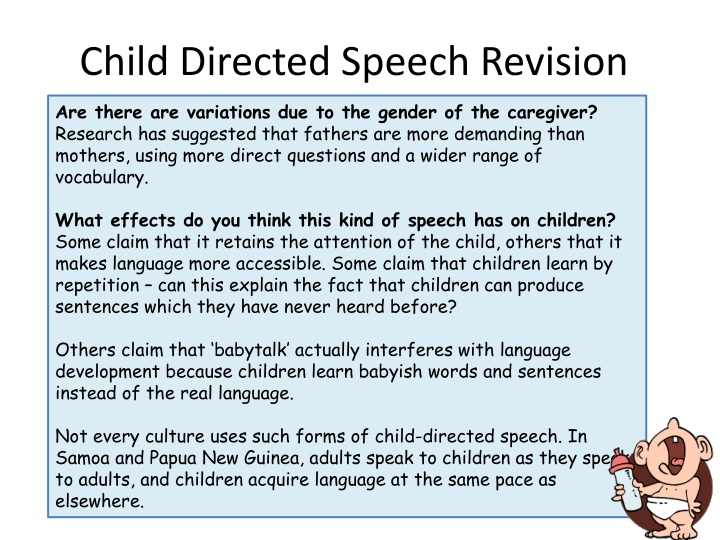


![Prevention and Combating of Hate Crimes and Hate Speech Bill [B.9B.2018]](/thumb/60513/prevention-and-combating-of-hate-crimes-and-hate-speech-bill-b-9b-2018.jpg)
